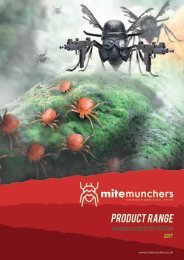MM Catalog3
You also want an ePaper? Increase the reach of your titles
YUMPU automatically turns print PDFs into web optimized ePapers that Google loves.
other preditors<br />
Diglyphus Isaea<br />
Type: Parasitic wasp.<br />
How it works: The wasp lays its eggs next to the<br />
leafminer larvae, damage ceases immediately as the<br />
larvae are paralysed. The wasp parasite larvae then feed<br />
on the leafminer larvae. Adult females kill and feed<br />
directly on small leafminer host larvae that are too<br />
small to support a developing parasite larva.<br />
Species controlled: Liriomyza (Tomato Leafminer) and<br />
Phytomyza (Chrysanthemum Leafminer).<br />
DIGLYPHUS ISAEA<br />
PARASETIC WASPS 250 PER CONTAINER<br />
£32.50<br />
When to use: Ideal for use from mid-February in heated<br />
crops and April in unheated crops. Establishment will<br />
only occur if the wasp is released when sufficient<br />
numbers of reasonable sized larvae are present within<br />
the crop.<br />
Rates of use: 1 wasp per 1 m2 every week for 3 to 4<br />
weeks.<br />
Feltiella Acarisuga Purpae<br />
Type: Spider mites<br />
How it works: Red or Two-Spotted Spider-Mites<br />
(Tetranychus urticae) feed by puncturing cells and<br />
draining the contents, producing a characteristic yellow<br />
speckling of the leaf surface. They also produce silk<br />
webbing which is clearly visible at high infestation<br />
levels. At very high infestation levels, reddish-brown<br />
masses of mites can be seen hanging from the tips of<br />
leaves. When populations of spider mite are this high,<br />
the pest can be transferred accidentally to clothing, and<br />
spread around the crop by workers.<br />
FELTIELLA ACARISUGA<br />
SPIDER MITE PREDATORY MIDGE (PUPAE)-250<br />
£71.76<br />
30











